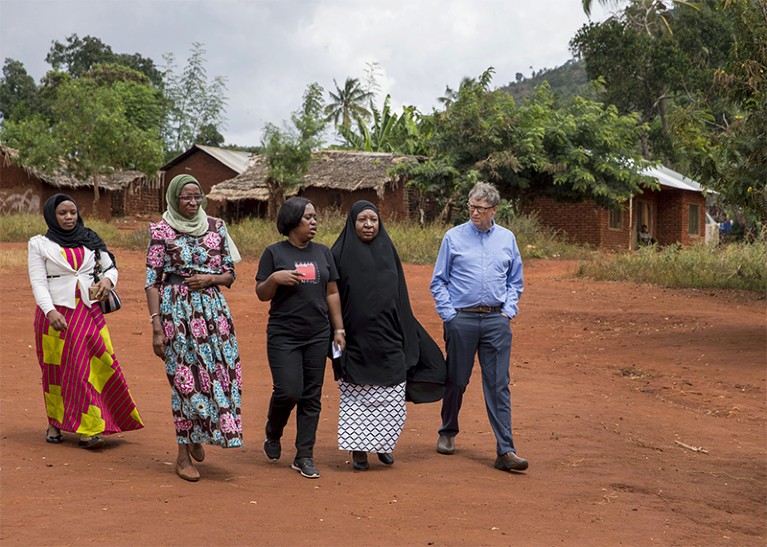
Illustration by Marcin Wolski
The US state of Washington, in the Pacific Northwest, was once the epicentre of the information-technology world, thanks to Microsoft and its founder, Seattle-born Bill Gates — until the dotcom boom sent investors down the coast to Silicon Valley. Now, Gates and other high-profile Microsoft alumni, along with other wealthy donors, are elevating the state as a major player in another sector: global health.
One survey, from the Washington Global Health Alliance (WGHA), an industry body that encourages collaboration between global-health organizations in the state, revealed that 207 local bodies see some of their activities as pertaining to global health. Those groups provide a diverse array of job opportunities in all aspects of the sector. “In Washington state, we have organizations that do everything from lab-based research, vaccines, diagnostics, data collection, service delivery, disaster response, down to last-mile logistics,” says Dena Morris, president and chief executive of WGHA. “Everything from beginning to end, there’s someone in the state working on it.”
Nathan Myhrvold was at Microsoft from 1986 to 2000, becoming the company’s chief technology officer in 1996. In 2000, he started the speculative patent firm Intellectual Ventures, based in Bellevue; this now has its own global-health branch, Global Good, which was set up with funding from Gates in 2012. Myhrvold says that the state has a range of specialist enterprises that make it particularly attractive to those involved in this sort of work. “The Seattle area is the Silicon Valley of saving the world,” he says.
In 2000, Gates established the Bill & Melinda Gates Foundation in Seattle, which has been the most significant contributor to the state’s global-health efforts. It has launched and funded several institutes and departments, both at the University of Washington, in Seattle, and at Washington State University, in Pullman — the state’s two largest higher education centres — as well as funding global health organizations based in the area.
In 2015, the foundation made US$4.1 billion in grants available globally. It estimates that, in the same year, it generated $1.5 billion in local economic activity, including some $340 million in direct grants to Washington-based research groups. Much of that money goes to the Seattle-based non-profit organization Program for Appropriate Technology in Health (PATH) and the University of Washington — both with a history of studying and fighting infectious diseases.
The Gates Foundation, which employs 1,200 people in Washington in a $500-million, 84,000-square-metre campus next to the city’s iconic Space Needle observation tower, is the world’s largest philanthropic funder of scientific research in terms of endowment. It employs a further 300 people outside Washington.
The hugeness of the foundation has generated criticism. Gates himself has asked why sharing wealth should be optional for billionaires, rather than mandated by government, through taxes or grants. Others have pointed to surveys showing that an increase in private grants for public health can remove incentives for local governments to invest their own resources in health care, precipitating an over-reliance on foreign aid. Still more have argued that the Gates approach to funding institutes over individuals has encouraged the global-health sector to behave more like a capitalist group than a charitable one, and have suggested that the foundation be overseen by an independent international body, such as the Paris-based Organisation for Economic Co-operation and Development.
The single biggest gift
The Gateses aren’t the only big philanthropists in town, nor is philanthropy limited to global health. Microsoft co-founder Paul Allen, who died last October, was another big spender in the region. Most famously, he launched the Seattle-based Allen Institute, which is organized into separate institutes specializing in brain science, cell science and artificial intelligence, along with a grant-awarding body. Rob Piercy, a spokesperson for the Allen Institute, told Nature that Allen had committed more than $1 billion since founding the first institute in 2003.
Warren Buffett is credited with much of the growth of the Gates Foundation. The businessman pledged $30 billion in 2006 — what Bill and Melinda Gates in their 2017 annual open letter called “the single biggest gift anyone has ever given anyone for anything”. That gift doubled the foundation’s resources.

Health workers give Bill Gates a tour of their work in the village of Kicheba, Tanzania, in 2017.Credit: Jonathan Torgovnik/Getty
As the Gates Foundation grew, and started to tackle more diseases in more countries, it needed better data to track and respond to outbreaks, says David Wertheimer, director of community and civic engagement at the foundation. To this end, it launched the Institute for Health Metrics and Evaluation (IHME) in 2007 with a $107-million grant, and has continued to support the centre, which is part of the University of Washington. Wertheimer says that the university was a natural home for the institute. Like PATH, which celebrated its 40th anniversary in 2017, the university was addressing global-health issues “long before the Gates Foundation ever existed”, he says.
The institute collects global data on diseases, mortality, morbidity and disability, which aids the Gates Foundation in planning its mission, Wertheimer says. “It will really help us allocate time, talent and resources to the challenges of global health.” William Heisel, director of global services at the IHME, says that the increased support of the Gates Foundation has helped the institute to grow from three people when it started to about 450 now.
Seeds of collaboration
What’s made the area so successful is how all these entities interact, he says. The IHME shares its data with local and regional organizations, and the Gates Foundation brings together a range of stakeholders; it has held more than 8,000 meetings since 2006, ranging from one-on-ones to conferences of hundreds. “It’s a very collaborative community here,” says Heisel.
Public-health specialist Dorothy Thomas says she sees and benefits from that community spirit. Thomas manages logistics at the non-profit organization VillageReach in Seattle, which aims to provide remote communities in the developing world with health care, and is building a database to track the price of delivering vaccine components to different parts of the world. She is working with scientists at the Gates Foundation, PATH and the University of Washington, among others, to build a map of their costs. She’s been pleased with the spirit of cooperation for that project. “There’s an openness, an excitement when it comes to sharing the work that they’ve been doing,” Thomas says.
Another characteristic of institutes in Washington is a focus on open-access publishing. The Allen institutes have remained committed to open-access research since they were founded, says Piercy. “No login, no password, no anything required to access the research,” he says. “It’s really the single biggest thing that sets us apart from other basic-science research institutes.”
The Gates Foundation also maintains strict open-access policies for the research it funds. Work paid for by the foundation must be published without an embargo, and in front of a paywall, in any journal that’s willing to make the research accessible. This approach has been taken a step further by an international consortium of European research funders, which plans to forbid publishing in anything other than fully open-access journals. The initiative is being led Robert-Jan Smits, the European Commission’s special envoy on open access, who cited the Gates Foundation as an inspiration.
Washington’s combination of open data and open doors makes it easy to collaborate with a wide sphere of people, says Heisel. “You are rarely in a room where it’s just charitable organizations speaking to themselves.”
Collaborations have emerged between academic, non-profit and commercial partners. For example, the IHME partnered with PATH to look at the effectiveness of immunizations by Gavi, a vaccine alliance based in Geneva, Switzerland. PATH provided on-the-ground insight, while the IHME collected and analysed data. “The ecosystem in Washington is ripe for this,” says David Fleming, PATH’s vice-president of public health. The state’s prosperity, paradoxically, causes some challenges, says Allan Jones, president and chief executive of the Allen Institute. Competition for talent is hot. For example, finding computational scientists can be tough with Facebook and Amazon often seeking similar skills. “We have to compete against that market and we do lose out,” Jones says.
The same goes for property. Facebook, Google and Amazon have bought property in popular South Lake Union, where, along with the Allen Institute, the University of Washington and the Fred Hutchinson Cancer Institute also have a presence.
Lee Hood, president of the Seattle-based Institute for Systems Biology, worries that the institute might have to move in two years, when its lease comes up for renewal. The Seattle area’s property market has cooled in recent months, but is still one of the most expensive areas in which to buy a home in the United States (see ‘Paddle your own canoe’). Thomas shares a house with five people to beat the rental market. She says that the biggest downside to the state, however, is Washington’s five-month rainy season. “Moisture is coming from every single possible direction that you can imagine,” she says. “That can be pretty rough.”
Up the coast from the valley
There is no shortage of global-health problems whose solutions involve advanced technology. For example, Global Good is developing a microscope that can automatically detect diseases such as malaria. The team uses machine-learning technology and pattern-matching software to enable the identification of pathogens that the human eye might miss. This improves the often poor quality of malaria microscopy, which plagues malaria management and elimination programmes; and it could greatly improve the effectiveness of malaria research worldwide, Myhrvold says.
The global-health ecosystem in Washington makes such inventions possible, he says. For example, if Global Good needs a biosafety laboratory to study tuberculosis, or mosquito samples to examine malaria, he can usually find collaborators. The sheer number of global-health organizations, combined with their willingness to work together, makes Washington state — and Seattle in particular — a special place to work, he says.
Many fellow technology specialists agree, Myhrvold says, and have joined him in moving to the sector. “They like working on some of this stuff. It’s fun. It makes you feel good about yourself, about the impact you have.”

 Join the disruptors of health science
Join the disruptors of health science
 An interview with Bill and Melinda Gates
An interview with Bill and Melinda Gates






